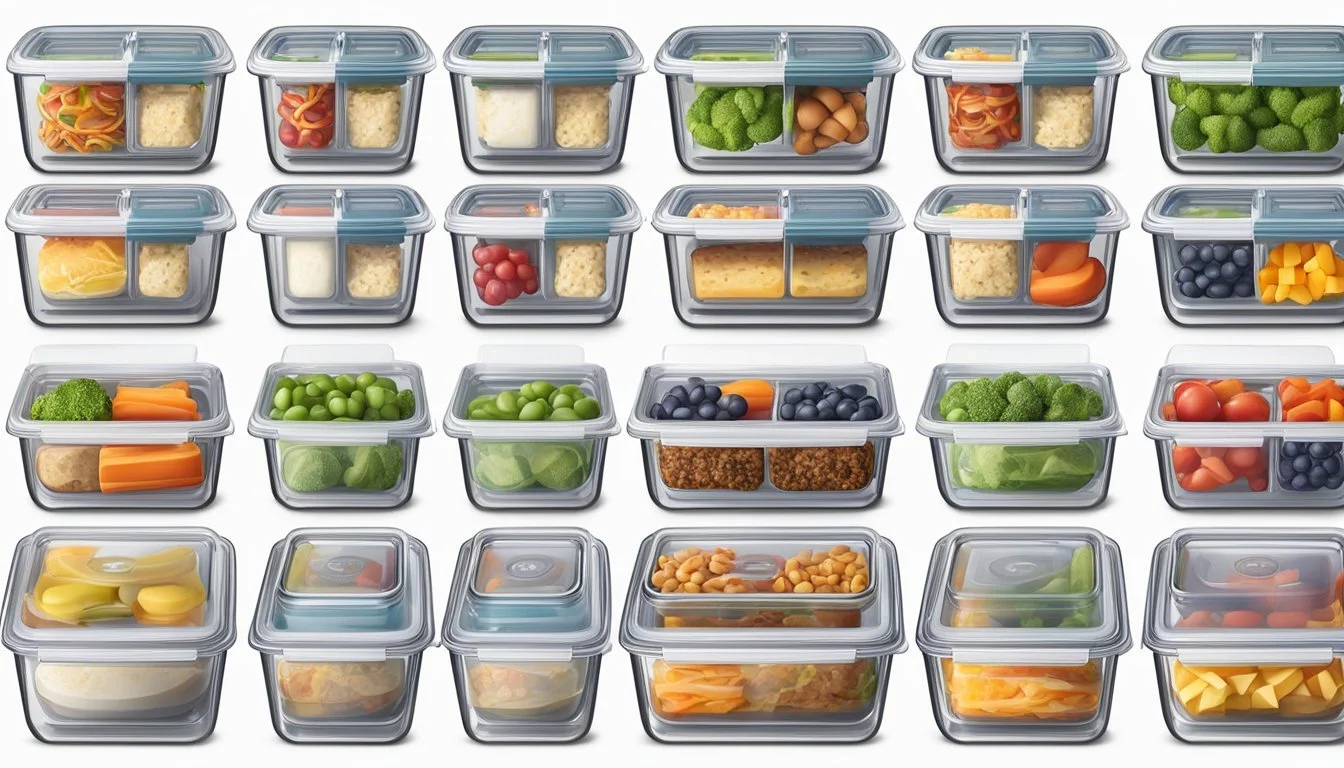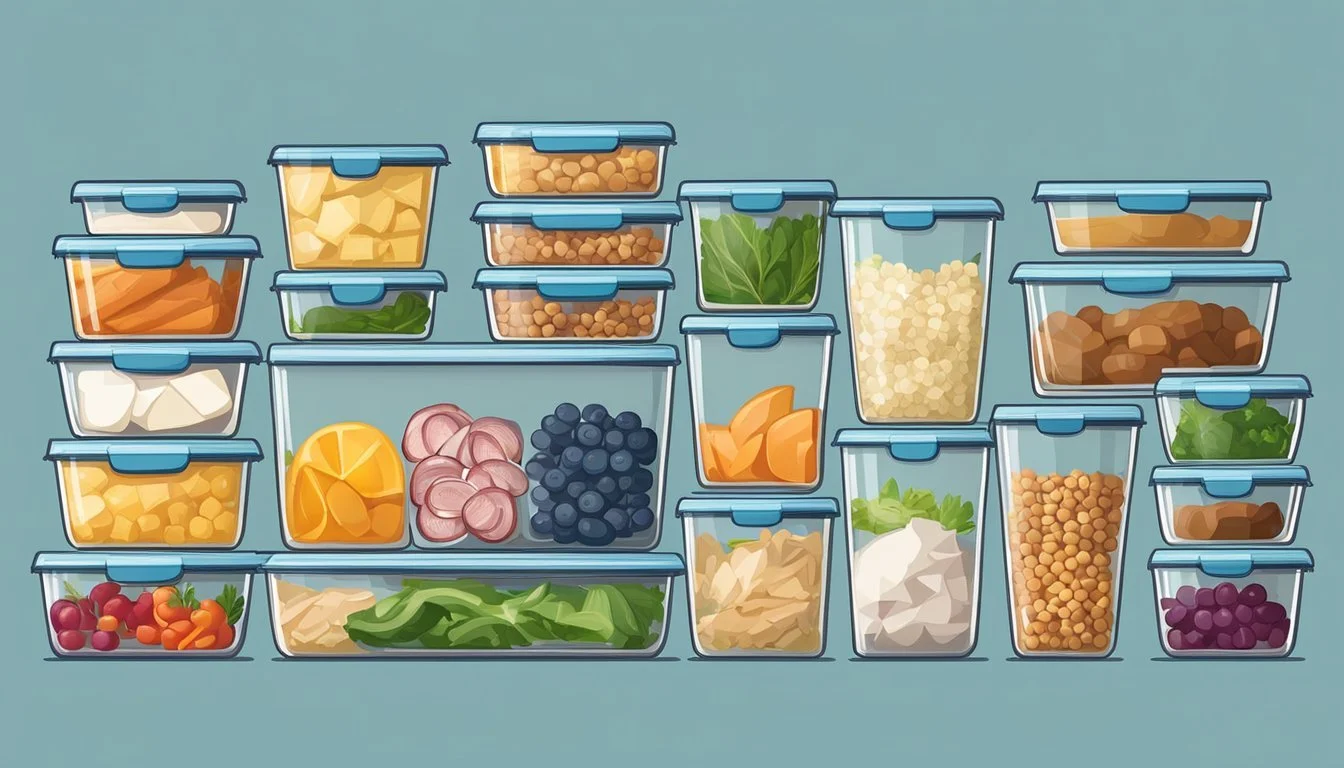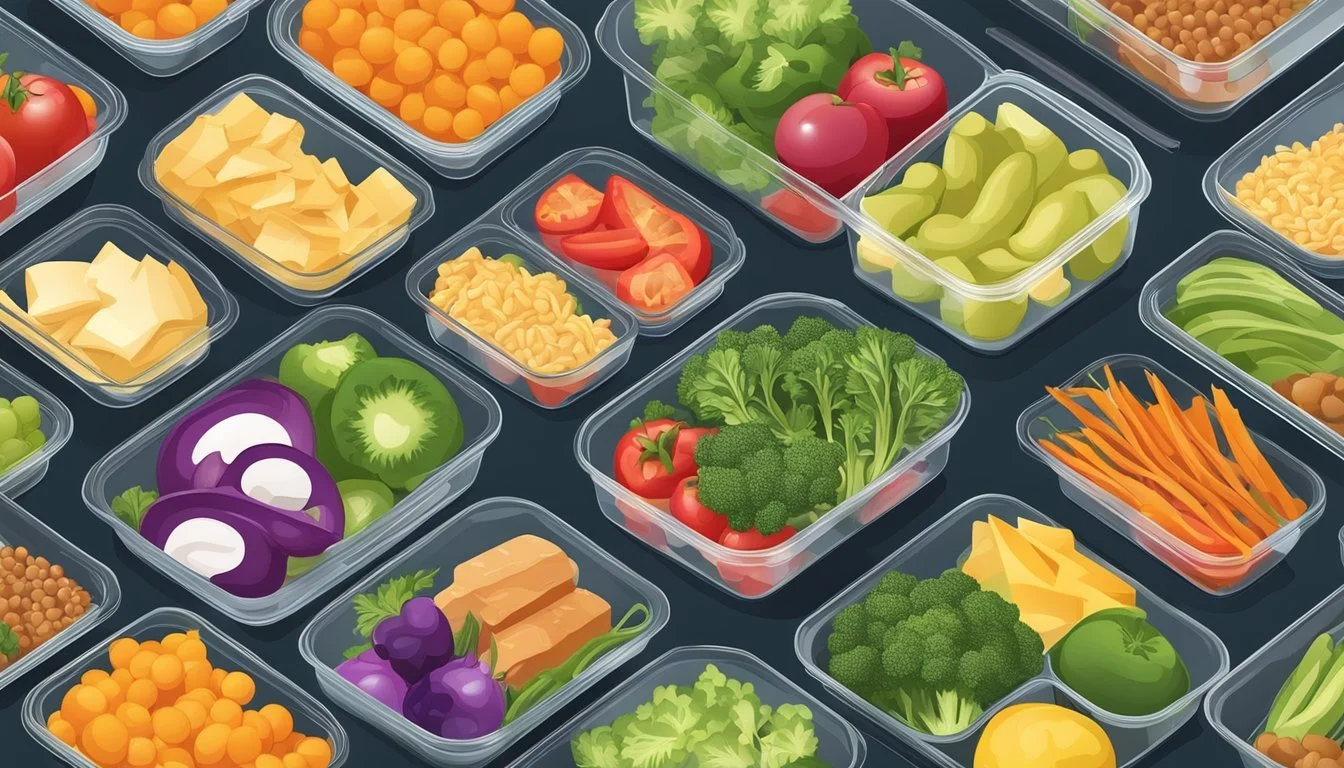The Ultimate Guide to Meal Prep Containers
Choosing Durable and Safe Options
Meal prep has emerged as a cornerstone of efficient and healthy eating, offering a variety of benefits that resonate with busy lifestyles, dietary goals, and budgetary constraints. As meal prepping grows in popularity, the choice of containers has become more than just an afterthought; it’s a fundamental aspect of the meal prep process. These containers play a vital role in the preservation of food, influencing its freshness and flavor. With the right kind of containers, individuals can streamline their meal prep process, ensuring that they have nutritious meals ready to go for days ahead.
When considering meal prep containers, durability, compartmentalization, and material safety are key factors. Glass containers, for example, are praised for their longevity and their ability to withstand microwave, oven, and dishwasher use without absorbing odors or staining. A good container is leakproof, maintains the integrity of the food, and aligns with one's dietary portion requirements. Container size is also crucial as it should match individual meal sizes and fit comfortably within one’s refrigerator or lunch (What wine goes well with lunch?) bag.
Selecting the best meal prep container isn't just a matter of personal preference but understanding how it impacts overall meal prep effectiveness. The variety of options on the market, from borosilicate glass to BPA-free plastics, two-compartment or three-compartment designs, and stackability for space-conservation, all contribute to making an informed choice. Understanding these characteristics ensures that meal prep is not only manageable but also contributes to a sustainable and healthy eating lifestyle.
Benefits of Meal Prepping
Meal prepping is the act of planning, preparing, and packaging meals in advance, typically for the entire week. This practice offers numerous advantages to those looking to maintain a healthy diet, manage their weight, and streamline their daily routines.
Healthy Eating: When individuals prep their meals, they can control the ingredients and portions that go into their food, ensuring each meal is balanced and nutritious. By doing so, they adhere more consistently to their dietary goals and resist the temptation of unhealthy, impromptu food choices.
Time-Saving: Preparing meals in batches often reduces the time spent cooking and choosing meals daily. It maximizes efficiency; one only needs to allocate a specific time slot for cooking, leading to more free time throughout the week.
Meal Prepping Advantages Healthy Eating Nutritional Quality Control Time-Saving Reduced Daily Cooking Time Cost-Effective Less Food Waste Weight Loss Portion Control Dietary Goals Tailored Meal Plans
Cost-Effective: Meal prepping allows for bulk purchasing and cooking, which can lower grocery bills. It minimizes waste, as one buys only what is needed, and reduces the frequency of eating out.
Weight Loss: Individuals find it easier to manage portions and calories through prepared meals. This consistent portion control is an effective strategy for those pursuing weight loss or maintaining a healthy weight.
In summary, meal prepping is a strategic approach that supports healthy eating, saves time and money, facilitates weight management, and helps achievement of dietary goals. It provides a structured solution to managing one's diet in the fast-paced world.
Essential Meal Prep Containers Features
Choosing the right meal prep containers involves considering material, size, design, and safety features. These elements ensure food stays fresh, portions are controlled, and storage is convenient.
Material Varieties and Their Advantages
Glass Containers: They are durable, eco-friendly, and do not retain odors or stains. Moreover, glass containers are often oven-safe, microwave-safe, freezer-safe, and dishwasher-safe, offering a high level of convenience and food safety.
Advantages:
Oven-safe up to certain temperatures
Non-reactive with acidic foods
Does not absorb odors
Plastic Containers: Typically lighter than glass, plastic meal prep containers come in BPA-free versions which are essential for health safety. Stainshield plastic options offer added resistance to food stains and odors.
Advantages:
Lightweight and usually more affordable
Many are freezer-safe and microwave-safe
Some come with airtight and leak-proof seals
Stainless Steel Containers: Stainless steel is robust, rarely breaks or cracks, and is inherently BPA-free. These containers are generally not microwave-safe but excel in durability.
Advantages:
Extremely durable
Eco-friendly and recyclable
Ideal for non-microwave use
Container Sizes and Their Uses
Single Servings: Small containers, 6-9 inches long and 2-3 inches deep, are useful for individual meal portions, promoting portion control and reducing food waste.
Family-Sized: Larger containers can store multiple servings for family meals or bulk meal prep, saving time and ensuring meal consistency throughout the week.
Design Considerations
Compartments: Containers with multiple compartments help separate different types of food, preventing flavors from mixing and preserving meal integrity.
Two-Compartment Containers: Ideal for keeping entrées and sides separate.
Stackable Design: Saves space in the fridge or cupboard.
See-Through: Clear containers or lids allow for easy identification of contents, streamlining the process of finding what's needed without having to open every container.
Safety and Durability Features
BPA-Free: Food-grade, BPA-free plastic is crucial for preventing chemical leaching into food, especially when used in microwave heating.
Leak-Proof and Airtight: These features protect against spills and preserve food freshness.
Durability:
Glass: High resistance to thermal shock.
Plastic: Resistant to breaking if dropped.
Stainless Steel: Nearly indestructible with proper care.
Easy to Clean: Dishwasher-safe containers facilitate clean-up and are more likely to maintain their appearance and hygiene over time.
Food storage is an integral part of meal prepping, and the right containers can make a great difference in maintaining the quality and safety of prepared meals.
Selecting the Right Containers for Different Meals
Choosing the right meal prep container ensures that food maintains its flavor, texture, and nutritional value. Each type of meal has specific container requirements to maximize freshness and convenience.
Containers for Breakfast Meals
Breakfast meals often consist of oats, smoothies, or yogurt with fruit. For oats and yogurt, look for containers with tight-sealing lids to prevent leaks. Glass containers are ideal as they can go from the fridge to the microwave if a hot breakfast is desired. For smoothies, single-serve bottles with secure lids are preferable, keeping the beverage fresh and spill-free.
Containers for Salads and Vegetables
Salads and raw vegetables demand containers that prevent sogginess. Bento boxes with compartments keep salads, vegetables, and healthy fats like avocados or dressings separated until ready to mix. Plastic or glass containers with ample space are preferred to prevent crushing delicate leaves.
Containers for Soups and Stews
Soups and stews need leak-proof containers, ideally made from glass or high-quality BPA-free plastic. Containers should be microwave-safe for reheating and have an airtight seal to prevent spills. Individual portions will ensure ease of warming and minimize waste.
Containers for Protein and Main Courses
Main courses with protein such as meat, fish, or tofu often require reheating. Select containers that can withstand high temperatures. Divided containers can keep protein, rice, or quinoa separate from sauces to maintain texture. Choose larger containers to hold full meals comfortably.
Containers for Snacks and Sides
Small to medium-sized containers are perfect for nuts, cut fruit, or side dishes. Containers with easy-to-open lids suit child-friendly snacks. Options like stackable containers save space and make for convenient storage both in the pantry and lunch bag.
Containers for Sandwiches and Lunch Items
Flat, rectangular containers accommodate sandwiches without squishing them. Bento-style lunch boxes are often the best choice, providing additional sections for sides or snacks. They keep the meal organized and prevent cross-contamination of flavors.
Meal Prep Techniques and Tips
In the realm of meal prepping, success hinges on effective strategies for meal planning, efficient batch cooking, and adeptness in storing and reheating. Mastery in portioning and organizing meals ensures a seamless integration of meal prepping into one's lifestyle.
Meal Planning Strategies
A structured meal plan is the cornerstone of meal prep. They should start by drafting a grocery list based on the week's menu, considering a balance of macronutrients. For beginners, it is fundamental to keep the plan simple, focusing on a mix of proteins, grains, and vegetables. Fresh n Lean offers inspiration for healthful and straightforward meal prep ideas.
Batch Cooking and Ingredient Prep
Batch cooking majorly cuts down time in the kitchen. They should cook large quantities of staples such as rice or chicken that can be used in various meals throughout the week. Proper ingredient prep ensures that meals are assembled quickly, involving chopping vegetables or marinating proteins ahead of time.
Storing and Reheating Techniques
Food safety and quality are preserved when meals are stored in adequate food storage containers. The Rubbermaid Brilliance food storage containers are an impeccable example, being leakproof and designed for stackability. Meals should be cooled before storing and reheated to the right temperatures to maintain freshness and flavor.
Portioning and Organizing Meals
Portion control is effortless with containers having separate compartments or two-compartment features. This facilitates maintaining serving sizes as per meal requirements, and it keeps ingredients from mixing. Organizing meals in stackable containers maximizes space and keeps the refrigerator neat.
Using these techniques and tips, meal prepping can become a streamlined process that not only saves time but also contributes to a healthier eating routine.
Maintaining Freshness and Preventing Contamination
When it comes to meal prep, two key considerations are ensuring that food remains fresh and is free from contamination. Airtight containers play a pivotal role in addressing both concerns. These containers restrict airflow, which can slow the oxidation process and help maintain the taste and texture of food.
Reusable containers are a cost-effective solution, and when they are made from high-quality materials, like BPA-free plastic or glass, they can endure repeated use without compromising food safety. To maximize efficiency and maintain food quality, one can consider categorizing and labeling containers based on their contents.
Preparing freezer meals requires particular care. Containers should be both freezer-safe to prevent freezer burn and appropriately sized to the portion to minimize empty space, which can lead to unnecessary air contact and ice crystal formation.
To summarize, here are the best practices in meal prep containers:
Airtight sealing: Ensure lids seal tightly to keep air out.
Proper sizing: Match container size to portion size for minimal air exposure.
Labeling: Clearly label containers with contents and prep dates.
Material: Opt for BPA-free plastics or glass for health and durability.
Freezer meals: Use freezer-safe containers and fill to reduce air space.
By carefully selecting and using proper containers, individuals can significantly extend the shelf-life of their food and minimize the risks associated with foodborne illnesses.
Innovations in Meal Prep Containers
Recent advancements in meal prep containers have catered to diverse consumer needs, ranging from durability to convenience. Innovations in this space have led to the development of containers from various materials, each with unique benefits.
Glass Meal Prep Containers: Consumers favor these for their non-porous nature, meaning they don't absorb food colors or smells. Brands like Pyrex and Prep Naturals have innovated with borosilicate glass, which withstands temperature changes without cracking. Lids are now designed to be leakproof, though typically not suitable for microwave or dishwasher use.
Steel Meal Prep Containers: Stainless steel options have emerged as a sturdy, rust-resistant alternative. They're praised for their sustainability and longevity, though they are not microwave-safe.
Compartmentalization: New designs feature multiple compartments, permitting meal component separation; thus, enhancing portion control and meal diversity. For example, the Pyrex Mealbox 10-Piece Divided Glass Food Storage Set offers convenience with 2-compartment storage.
Metal Containers: Metal meal prep containers, although less common than glass or plastic, appeal to those seeking highly durable options. They often include secure lids and are ideal for on-the-go meals, though their use is limited in microwaveable food preparation.
These innovations reflect the consumer's desire for meal prep containers that are safe, convenient, and capable of preserving food quality. Each material offers different advantages, whether it be the longevity of metal or the microwave-friendliness of glass. Manufacturers continue to refine designs, ensuring meal prep is as efficient and enjoyable as possible.
Budget-Friendly Meal Prep Solutions
When selecting meal prep containers, budget-conscious individuals should consider both the cost and the durability to ensure they are getting the best value over time. Plastic meal prep containers are often the most cost-effective option. Containers such as NutriBox offer the practicality of being top-rack dishwasher safe and easily stackable, making them convenient for those with limited storage space.
Here is a breakdown of some budget-friendly attributes to look for:
Reusable: Look for containers that can withstand repeated use, which will stretch your dollar further.
Stackable: Efficient storage can save space and simplify organization in the kitchen.
Microwave safe: Containers that can transition from fridge to microwave can reduce the need for additional dishes.
Dishwasher safe: Easy-to-clean containers save time and effort, ensuring they're ready for your next meal with minimal fuss.
Size (oz) Brand Dishwasher Safe Microwave Safe 24 NutriBox Yes (top-rack) Yes Varies Rubbermaid Yes Yes Varies Pyrex Yes Yes
For a more eco-friendly approach, shoppers might consider glass containers such as those from Pyrex. Although they may have a higher initial cost, their durability often justifies the investment.
In summary, those seeking budget-friendly meal prep containers have options ranging from plastic to glass. Each has its own set of features that appeal to different budgeting needs and food storage requirements. It is essential to weigh initial costs against long-term usability to make the most financially sensible decision.
Environmental Impact and Sustainability
When considering the environmental impact of meal prep containers, one must recognize the importance of sustainability in the selection process. Eco-friendly meal prep containers offer a solution to reduce waste and support a healthier environment.
Materials:
Glass: Durable and recyclable, glass containers are a sustainable option, often outlasting their plastic counterparts.
Stainless Steel: Known for their longevity, these containers are fully recyclable and don't leach chemicals.
BPA-free Plastic: While less ideal than glass or steel, BPA-free plastic options are reusable and more lightweight.
Reusable vs. Single-Use: Consumers are encouraged to choose reusable containers to minimize their ecological footprint. Reusable containers, as opposed to single-use alternatives, result in less waste entering landfills and oceans.
Benefits of Reusable Containers Reduces waste ✓ Lowers contamination risk ✓ Conserves resources ✓
Eco-Friendly Practices: Meal preppers should consider the following practices to enhance sustainability:
Source healthy food from local, sustainable farms to lower transportation emissions.
Prefer containers from recycled materials.
Utilize container sizes that match portion sizes to avoid food waste.
Sustainability Beyond Containers: The impact of meal prep extends beyond just choosing containers. Advocates for the environment recommend planning meals to use seasonal ingredients and composting organic waste to create a holistic eco-friendly approach.
In essence, the drive toward sustainability in meal prep involves a combination of eco-conscious container choices, reducing waste, and mindful food sourcing. Thus, one's commitment to the environment is reflected not only in their container selection but also in their overall meal prep practices.
Meal Prep for Specific Dietary Goals
When individuals aim to meet specific dietary goals, such as weight loss or maintaining a balanced diet, meal prep containers become a crucial tool for portion control and organization. They select containers that help them adhere to their diet, whether it's calorie counting, macro tracking, or simply ensuring they have healthy meals at the ready.
For Weight Loss:
Portion Control: Containers with compartments encourage proper portion sizes.
Clear Labeling: Transparent containers allow for easy identification of foods and adherence to calorie limits.
For Healthy Meals:
Quality Materials: BPA-free plastic or glass containers keep foods fresh without harmful chemicals.
Airtight Seals: This feature maintains the freshness and prevents nutrient loss.
For Dietary Goals:
Color Coding: Designating colors for different macronutrients ensures balanced meals.
Stackability: Efficient space use in the fridge encourages prep and storage of multiple healthy meals.
When selecting containers, individuals consider durability, whether they are microwave and dishwasher safe, and if they offer the needed functionality, from insulated bags to freezable lids, ensuring prepared meals contribute to their dietary success.
Table Example for Container Features:
Feature Benefit Leak-proof Prevents spills, suitable for soups Insulated Keeps temperature-controlled meals safe Compartmentalized Manages portions, separates food types
They ensure meal prep aligns with their dietary goals, using containers as a visual and practical guide for portion sizes and nutritional content, playing a significant role in their success.
Conclusion
Selecting the right meal prep containers is pivotal for an efficient and sustainable meal prepping routine. Glass containers are recommended for their durability and non-reactive nature, ensuring that food flavors remain unaltered and avoiding harmful chemicals. They are typically microwave, oven, freezer, and dishwasher safe, which accommodates a variety of meal types and storage needs.
Plastic containers may be more cost-effective and lightweight, making them convenient for transport. However, users should opt for BPA-free options and ensure they are suitable for their intended use, such as microwave or freezer use.
When choosing containers, one should consider size and compartmentalization based on their meal planning. Smaller containers can cater to breakfast items or snacks, while larger ones can store full meals. Multiple compartments offer separation of different food items, aiding in portion control and preserving the meal composition.
A leak-proof seal is valuable for food safety and preventing spills, especially for meals in transit. Containers should also be easy to clean and designed to resist odor retention, ensuring usability for a diversity of meals.
Investing in quality meal prep containers aligns with the overarching goals of meal prepping: to save time, eat healthily, and manage portions effectively. With the appropriate containers, preppers can maintain freshness, taste, and nutritional value of their meals while streamlining their meal planning process.








